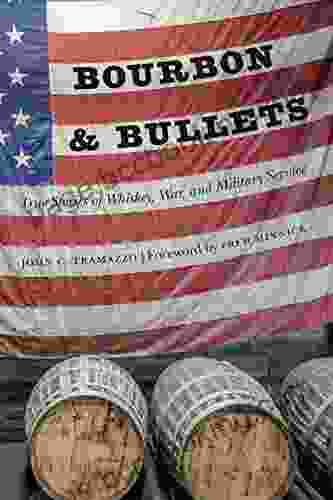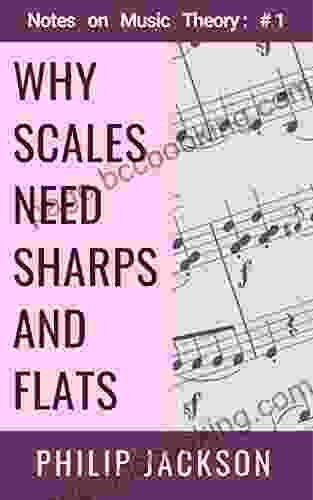Why Scales Need Sharps And Flats

Sharps and flats are two of the most essential musical symbols. They are used to indicate the raising or lowering of a note's pitch, and they play a vital role in the construction of scales and chords. Without sharps and flats, music would be much more limited and monotonous.
What are sharps and flats?
A sharp (#) raises the pitch of a note by one half step. A flat (b) lowers the pitch of a note by one half step. For example, the note C# is one half step higher than the note C, and the note Cb is one half step lower than the note C.
4.4 out of 5
| Language | : | English |
| File size | : | 1925 KB |
| Text-to-Speech | : | Enabled |
| Screen Reader | : | Supported |
| Enhanced typesetting | : | Enabled |
| Word Wise | : | Enabled |
| Print length | : | 40 pages |
| Lending | : | Enabled |
Sharps and flats can be used to create scales and chords that would not be possible otherwise. For example, the C major scale contains the notes C, D, E, F, G, A, and B. However, if we want to create a scale that starts on the note G, we need to use a sharp to raise the pitch of the note F to F#. This gives us the G major scale, which contains the notes G, A, B, C, D, E, and F#.
How to use sharps and flats
Sharps and flats are used in a variety of musical contexts. Here are a few of the most common:
- Scales: Sharps and flats are used to create different scales. For example, the C major scale contains the notes C, D, E, F, G, A, and B. The C minor scale contains the notes C, D, Eb, F, G, Ab, and Bb.
- Chords: Sharps and flats are used to create different chords. For example, the C major chord contains the notes C, E, and G. The C minor chord contains the notes C, Eb, and G.
- Melodies: Sharps and flats can be used to create melodies that are more interesting and varied. For example, the melody of the song "Twinkle, Twinkle, Little Star" contains the notes C, D, E, F, G, A, and B. However, if we want to create a melody that is more chromatic, we can use sharps and flats to raise or lower the pitch of some of the notes.
Sharps and flats are essential musical symbols that play a vital role in the construction of scales and chords. They can also be used to create melodies that are more interesting and varied. Understanding sharps and flats is essential for any musician who wants to read and write music.
4.4 out of 5
| Language | : | English |
| File size | : | 1925 KB |
| Text-to-Speech | : | Enabled |
| Screen Reader | : | Supported |
| Enhanced typesetting | : | Enabled |
| Word Wise | : | Enabled |
| Print length | : | 40 pages |
| Lending | : | Enabled |
Do you want to contribute by writing guest posts on this blog?
Please contact us and send us a resume of previous articles that you have written.
 Book
Book Novel
Novel Page
Page Chapter
Chapter Text
Text Story
Story Genre
Genre Reader
Reader Library
Library Paperback
Paperback E-book
E-book Magazine
Magazine Newspaper
Newspaper Paragraph
Paragraph Sentence
Sentence Bookmark
Bookmark Shelf
Shelf Glossary
Glossary Bibliography
Bibliography Foreword
Foreword Preface
Preface Synopsis
Synopsis Annotation
Annotation Footnote
Footnote Manuscript
Manuscript Scroll
Scroll Codex
Codex Tome
Tome Bestseller
Bestseller Classics
Classics Library card
Library card Narrative
Narrative Biography
Biography Autobiography
Autobiography Memoir
Memoir Reference
Reference Encyclopedia
Encyclopedia Pixie Unger
Pixie Unger Paul Dryburgh
Paul Dryburgh Sabine Charles
Sabine Charles Robert Richard
Robert Richard Tanya Tagaq
Tanya Tagaq Teri Kanefield
Teri Kanefield Paulette Harper
Paulette Harper Philip Yancey
Philip Yancey Pam Fessler
Pam Fessler Nitish Singh
Nitish Singh Rachel Ignotofsky
Rachel Ignotofsky Polly Barton
Polly Barton Peter Crossland
Peter Crossland Samuel Lawson
Samuel Lawson Paul Doty
Paul Doty Nyla Nuray
Nyla Nuray Phoenix Grey
Phoenix Grey Rockridge Press
Rockridge Press Valerie Howard
Valerie Howard Ren Lowe
Ren Lowe
Light bulbAdvertise smarter! Our strategic ad space ensures maximum exposure. Reserve your spot today!
 Rodney ParkerFollow ·19.1k
Rodney ParkerFollow ·19.1k Heath PowellFollow ·11.1k
Heath PowellFollow ·11.1k Todd TurnerFollow ·13.5k
Todd TurnerFollow ·13.5k Gage HayesFollow ·4.5k
Gage HayesFollow ·4.5k Ryan FosterFollow ·7.6k
Ryan FosterFollow ·7.6k George HayesFollow ·14.6k
George HayesFollow ·14.6k Donovan CarterFollow ·15.8k
Donovan CarterFollow ·15.8k Edgar Allan PoeFollow ·5.1k
Edgar Allan PoeFollow ·5.1k

 Marvin Hayes
Marvin HayesGoverning Law for Law School and Bar Exam Prep: Your...
Unlock the Secrets of...

 Sidney Cox
Sidney CoxUnveiling the Epic Tales of Whiskey, War, and Military...
In the tapestry of history,...

 Victor Turner
Victor TurnerGoverning Law for Law School and Bar Exam Prep: The...
What is Governing...

 Robert Browning
Robert BrowningSterling Test Prep MCAT General Chemistry Practice...
: Embark on Your MCAT General Chemistry...
4.4 out of 5
| Language | : | English |
| File size | : | 1925 KB |
| Text-to-Speech | : | Enabled |
| Screen Reader | : | Supported |
| Enhanced typesetting | : | Enabled |
| Word Wise | : | Enabled |
| Print length | : | 40 pages |
| Lending | : | Enabled |
















